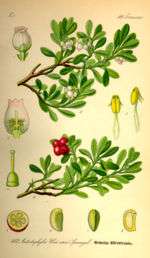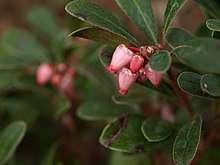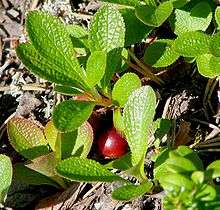Bearberry
Bearberries (indigenous kinnickinnick) are three species of dwarf shrubs in the genus Arctostaphylos. Unlike the other species of Arctostaphylos (see manzanita), they are adapted to Arctic and Subarctic climates, and have a circumpolar distribution in northern North America, Asia and Europe.


Description
Bearberries grow as low-lying bushes and these shrubs are green coloured year round.[1] Furthermore, one can see from the images that they have a round shape to them as well.[1] They are capable of surviving on soils predominantly composed of sand.[1] In Canada, you can find them in the Northern Latitude forests, and they can are also found growing on gravel surfaces.[2]
Species
The name "bearberry" for the plant derives from the edible fruit which is a favorite food of bears.[3] The fruit are edible and are sometimes gathered as food for humans. The leaves of the plant are used in herbal medicine.[4]
- Alpine bearberry: Arctostaphylos alpina (L.) Spreng (syn. Arctous alpinus (L.) Niedenzu). This is a procumbent shrub 10–30 cm high (3.9–11.8 in). Leaves not winter green, but dead leaves persist on stems for several years. Berries dark purple to black. Distribution: circumpolar, at high latitudes, from Scotland east across Scandinavia, Russia, Alaska, Canada and Greenland; southern limits in Europe in the Pyrenees and the Alps, in Asia to the Altay Mountains, and in North America to British Columbia in the west, and Maine and New Hampshire in the United States in the east.
- Red bearberry: Arctostaphylos rubra (Rehd. & Wilson) Fernald (syn. Arctous rubra (Rehder and E.H. Wilson) Nakai; Arctous alpinus var. ruber Rehd. and Wilson). This is a procumbent shrub 10–30 cm high (3.9–11.8 in). Leaves deciduous, falling in autumn to leave bare stems. Berries red. Distribution: in the mountains of Sichuan, southwestern China north and east to eastern Siberia, Alaska and northern Canada east to northern Quebec.
- Common bearberry: Arctostaphylos uva-ursi (L.) Spreng.
Uses

The plant contains diverse phytochemicals, including ursolic acid, tannic acid, gallic acid, some essential oils and resin, hydroquinones (mainly arbutin, up to 17%), tannins (up to 15%), phenolic glycosides and flavonoids.[4]
The berries ripen late in the year, and can be eaten raw.[5]
Folk medicine
The leaves are picked any time during the summer and dried for use in teas, liquid extracts, medicinal tea bags and tablets for traditional medicine uses.[6] Bearberry appears to be relatively safe, although large doses may cause nausea, vomiting, fever, chills, back pain and tinnitus.[7] Cautions for use apply during pregnancy, breast feeding, or in people with kidney disease.[6][8]
The efficacy and safety of bearberry treatment in humans remain unproven,[7] as no clinical trials exist to interpret effects on any disease.
History and folklore
Bearberry was first documented in The Physicians of Myddfai, a 13th-century Welsh herbal. It was also described by Clusius in 1601, and recommended for medicinal use in 1763 by Gerhard and others. Often called uva-ursi, from the Latin uva, "grape, berry of the vine", ursi, "bear", i.e. "bear's grape". It first appeared in the London Pharmacopoeia in 1788.
Folk tales suggest Marco Polo thought the Chinese were using it as a diuretic. Bearberry leaves are used in traditional medicine in parts of Europe, and are officially classified as a phytomedicine.[4] Native Americans use bearberry leaves with tobacco and other herbs in religious ceremonies, both as a smudge (type of incense) or smoked in a sacred pipe carrying the smoker's prayers to the Great Spirit. When mixed with tobacco or other herbs, it is referred to as kinnikinnick, from an Algonquian (probably Delaware) word for "mixture". Among the ingredients in kinnikinnick were non-poisonous sumac leaves,[9] and the inner bark of certain bushes such as red osier dogwood (silky cornell),[9] chokecherry, and alder, to improve the taste of the bearberry leaf.[10]
References
- Amarowicz, Ryszard; Pegg, Ronald B. (2013-04-01). "Inhibition of proliferation of human carcinoma cell lines by phenolic compounds from a bearberry-leaf crude extract and its fractions". Journal of Functional Foods. 5 (2): 660–667. doi:10.1016/j.jff.2013.01.009. ISSN 1756-4646.
- Beryl Hallworth (March 4, 2015). "Bearberry". The Canadian Encyclopedia. Retrieved 2020-03-19.
- Janice J. Schofield (1989). Discovering wild plants: Alaska, western Canada, the Northwest. p. 217. ISBN 978-0-88240-355-7.
- Pegg, Ronald B.; Rybarczyk, Anna and Amarowicz, Ryszard (2008) "Chromatographic Separation of Tannin Fractions from a Bearberry-leaf (Arctostaphylos Uva-ursi L. Sprengel) Extract by Se-hplc – a Short Report" Polish Journal of Food and Nutrition Sciences 58(4): pp. 485–490
- Lyons, C. P. (1956). Trees, Shrubs and Flowers to Know in Washington (1st ed.). Canada: J. M. Dent & Sons. p. 196.
- Blumenthal M (translation from German) (1998). Therapeutic Guide to Herbal Medicines. American Botanical Council. Thieme. ISBN 978-0-9655555-0-0.
- Allen C. Bowling (2006). Complementary and Alternative Medicine and Multiple Sclerosis. Demos Medical Publishing. p. 127. ISBN 978-1-932603-54-5.
- Nordeng H. and Havnen, G.C. (2005) "Impact of socio-demographic factors, knowledge and attitude on the use of herbal drugs in pregnancy" Acta Obstetricia et Gynecologica Scandinavica 84(1): pp. 26–33, note 16, doi:10.1111/j.0001-6349.2005.00648.x
- Upham, Warren (2001). Minnesota Place Names: A Geographical Encyclopedia. Minnesota Historical Society Press. p. 481. ISBN 978-0-87351-396-8.
- Staff (2009) "Bearberry" Archived 2010-12-18 at the Wayback Machine Discovering Lewis and Clark The Lewis and Clark Fort Mandan Foundation
| Wikimedia Commons has media related to Arctostaphylos alpina. |
| Wikimedia Commons has media related to Arctostaphylos uva-ursi. |